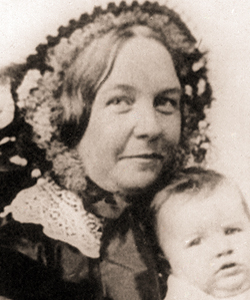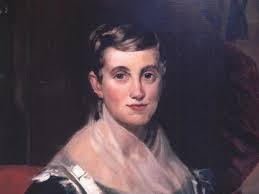“make the puddings and carry the baby while I ply the pen”
(What she said to unmarried, non-mom and best gal pal Susan B. Anthony)
Elizabeth Cady Stanton, super smart, greatly gifted and tremendously talented, was raised with privilege, education, and the knowledge that she would NEVER be treated equally because of her gender. Her father was a judge, a congressman, an Associate Justice to the Supreme Court – and – a sexist. One of five girls born into a wealthy connected New York family, her mother Margaret suffered through eleven pregnancies and bore five sons, four of whom died in childhood. Elizabeth began to understand the subordinate role of girls and women when her twenty-year-old brother Eleazer died suddenly at the age of twenty. The apple of her father’s eye, he was the only surviving son and only one to legally inherit the family fortune (women could not own property and anything they had legally went to their husbands). Her grief – stricken father told her “I wish you were a boy” to which she replied, “I will try to be all that my brother was”. And try she did, to get her father to say, “Well, a girl is as good as a boy”. Instead, he said, “Ah, you should have been a boy”. Surrounded by law, she learned early on its power. One story has young, determined, naïve Elizabeth planning to take a scissor and cut the unfair laws out of her father’s law books after witnessing a procession of “weeping women” coming to her home desperate and destitute begging Judge Cady for help, but being unprotected by the laws. Her father explained the legal process involved in changing laws, and the seed was planted that grew into the first Women’s Rights Convention in 1848 in Seneca Falls. She refused to have the word “obey” in her marriage vows, and just added her husband’s name to hers setting that trend. She spent her life being discriminated against for being a woman and fought – many times alone – first for abolition and then tirelessly for the right to vote for “all citizens” – not just male citizens – introducing the concept of gender bias to the legal world and splitting the women’s movement into two factions; one who were willing to wait their turn to vote and one who were not. She would not. She never stopped fighting for property rights, divorce reform, equal education, fair pay, labor laws, daycare, legal identity and a professional life. Her partner in all of this was Susan B. Anthony, who would come over and take on some of the domestic drudgery so Elizabeth could write the fabulous speeches that Anthony would give. The two of ‘em really shook things up, trailblazing though the eighteen hundreds. “Marriage”, said Elizabeth, was the “transfer of power from one master to another”. She had her seventh child at the age of forty-three and at the tender age of eighty-three, her groundbreaking and controversial book “The Woman’s Bible” was published, accusing religion of keeping woman down and describing the Bible as an historical rather than sacred document. After her brother’s death she thought, “the chief thing to be done in order to equal boys was to be learned and courageous”. Was she ever….. an ultimate role model and the architect of the Women’s Movement.


